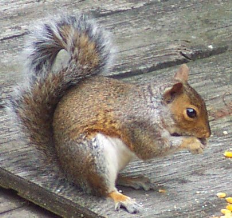
Tree Squirrels
SCIURUS SPP. TAMIASCIURUS SPP.
Color: White to gray, yellow, red and brown with a pale, dark belly
Legs: 4
Shape: Long body covered with short, thick fur, bushy tail
Size: Head and body is 6-15” and tail is 4-14”
Region: Found throughout the U.S.
OVERVIEW
Tree squirrels get their common name from the fact that they are found only in areas where there are trees. There are three representative species of tree squirrels: fox squirrels, gray squirrels and pine squirrels.
HABITS
Fox squirrels are most active in the morning and late afternoon often burying nuts for winter use. They feed mainly on hickory nuts and acorns, but also eat the fruit of tulip poplar, maple tree seeds, corn bordering woods, berries, bird eggs and fungi. Gray Squirrels are active year round, but most productive in the morning and evening on dry days. Gray squirrels feed primarily on nuts, especially hickory nuts, acorns, beechnuts and walnuts. In addition, they occasionally feed on maple or tulip tree seeds, fruit, opening buds and corn. Pine Squirrels are active year round, especially in the morning and evening. However, they are sometimes active after dark as well. Pine squirrels feed on a great variety of seeds, nuts, berries, bird eggs and fungi.
HABITATS
Fox squirrels favor oak-hickory forests, but they are found in pine forests and cypress and mangrove swamps in the south. During the summer months, fox squirrels make leaf nests in trees and they often overwinter in a common tree hole. Gray squirrels are found in hardwood or mixed forests with nut trees, especially oak-hickory forests and river bottoms. In the summer, gray squirrels nest in tree cavities or build nests made of leaves in branches. In the winter months, they are known to invade structures and homes looking for a place to overwinter. Pine squirrels are often abundant in any kind of forest and are commonly found around buildings. Pine squirrels usually nest in tree cavities or nests made of leaves, twigs and bark.
THREATS
All three species of tree squirrels are considered a household pest because they frequently enter attics in the winter; however, they rarely pose a health threat to homeowners. Outdoors, these squirrels can cause considerable damage to electrical and telephone cables.


